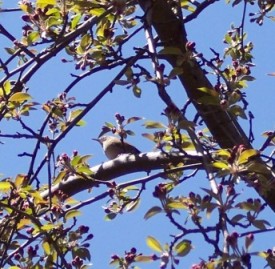My dad maintains bluebird houses on his property, so he doesn’t like House Wrens, and I can’t blame him. They’re an aggressive little bird; they’ll go so far as to destroy the eggs of other birds nesting in their territory. Perhaps this is why they are also a successful little bird. According to Cornell University, they have “one of the most extensive ranges of any bird in terms of latitude.”
My suburban home isn’t bluebird habitat, however, so I’m glad to have wrens about. It’s partly nostalgia — wrens used to nest under the eves of the cottage where spent summers with my grandparents, on Cayuga Lake. And it’s partly because hanging a wren box is all but guaranteed to attract a House Wren — they’re so common, and they seem to like being around people. The name “House Wren,” in fact, derives from their tendency to nest near human houses.
So I’ve hung a nest box in the flowering crab apple in the backyard, and every year a pair settles in to raise a family.
I heard one sing for the first time this year, a couple of days ago, and managed to get a photo of him yesterday.

The best way to identify wrens (other than their song, which I’ll get to in a sec) is their profile, particularly their tail, which they carry pointed upward at a feisty angle. Their plumage, otoh, is an unremarkable, dull brown, making the females a stand-in for modesty, as in the verse “When Jenny Wren Was Young” from The Real Mother Goose:
‘Twas once upon a time, when Jenny Wren was young,
So daintily she danced and so prettily she sung,
Robin Redbreast lost his heart, for he was a gallant bird.
So he doffed his hat to Jenny Wren, requesting to be heard.“Oh, dearest Jenny Wren, if you will but be mine,
You shall feed on cherry pie and drink new currant wine,
I’ll dress you like a goldfinch or any peacock gay,
So, dearest Jen, if you’ll be mine, let us appoint the day.”Jenny blushed behind her fan and thus declared her mind:
“Since, dearest Bob, I love you well, I’ll take your offer kind.
Cherry pie is very nice and so is currant wine,
But I must wear my plain brown gown and never go too fine.”
Perhaps Jenny Wren’s suitability as wife to the more stylish English Robin is related to her royal lineage: the wren is considered King of the Birds. It’s a title won by trickery, however. When the birds decided the one who could fly the highest would be their king, the wren hid itself in the feathers of an Eagle. The Eagle flew as high as it could, and then the well-rested wren emerged and flew yet higher, winning the crown.
A darker bit of Old World folklore is the hunting of the wren:
Down to the present time the ‘hunting of the wren’ still takes place in parts of Leinster and Connaught (in Ireland). On Christmas Day or St Stephen’s Day the boys hunt and kill the wren, fasten it to the middle of a mass of holly and ivy on the top of a broomstick, and on St Stephen’s Day (26 December) go about with it from house to house, singing: “The wren, the wren, the king of all birds,/St Stephen’s Day was caught in the furze;/Although he is little, his family’s great,/I pray you, good landlady, give us a treat.” Money or food (bread, butter, eggs, etc.) were given them, upon which they feasted in the evening’ (Golden Bough, 1 vol. ed. Macmillan, 1963 (originally 1922), pp. 536-7). – In England such rituals died out in the nineteenth century, but the song survived.
The origins of the ritual aren’t clear — Wikipedia mentions a tradition that Saint Stephen was betrayed by a wren, but the scholarship in the piece linked above suggests it predates Christianity.
Here in North America, the wren’s significance is considerably more prosaic: when the wrens have returned, you know it’s truly spring.
You can’t miss a wren’s song, either. It’s distinctive (my grandfather called it a “bubble de bubble”) and delightful, and also loud — Native Americans called the House Wren “o-du-na-mis-sug-ud-da-we-shi, (making a big noise for its size)” (although apparently it plays second fiddle to its close relative, the Winter Wren, which has the distinction of a song with “10 times more power than a crowing rooster” ).
Yep, you can’t miss them.
And now they’re back. There’s still time, too, if you want to enjoy wrens around your house this year. You can find wren houses in hardware and big box building supply chains — they’re the small, cheap ones ;-)
Meanwhile, here’s a Cornell web page where you can get info on house wrens, including a wav file of its song so you can hear that bubble de bubble for yourself.
